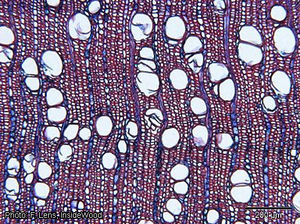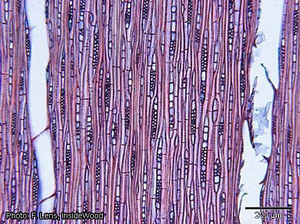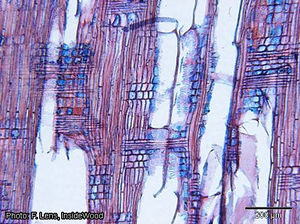Chrysophyllum pruniforme (PROTA)
Introduction |
Chrysophyllum pruniforme Pierre ex Engl.
- Protologue: Monogr. afrik. Pflanzen-Fam. 8: 42 (1904).
- Family: Sapotaceae
- Chromosome number: 2n = 26, 28
Synonyms
- Donella pruniformis (Pierre ex Engl.) Aubrév. & Pellegr. (1961).
Origin and geographic distribution
Chrysophyllum pruniforme is widely distributed from Sierra Leone east to western Uganda and western Tanzania.
Uses
In Tanzania the wood is used for construction, grain mortars and beehives. In West Africa it is used for house construction. In Congo a tea made from the bark is drunk to treat cough. In some regions the fruit pulp is reported as edible, but in others as inedible.
Properties
The wood is yellowish white and moderately hard.
Description
- Medium-sized tree up to 30(–40) m tall; bole up to 80(–100) cm in diameter, straight and cylindrical, fluted or slightly buttressed at base; bark surface dark brown to blackish, fissured, inner bark pale brown, fibrous, exuding a little latex; young branches reddish brown hairy.
- Leaves distichously alternate, simple and entire; stipules absent; petiole 0.5–1 cm long, slender; blade elliptical to ovate-oblong, 4–11(–13) cm × 2–5(–6.5) cm, asymmetrically cuneate at base, long-acuminate at apex, leathery, glabrous, pinnately veined with numerous, closely spaced lateral veins.
- Flowers in axillary fascicles, regular, 5-merous; pedicel 2–3.5 mm long; sepals free, orbicular, up to 2 mm long, slightly pubescent to glabrous outside; corolla with up to 1 mm long tube and rounded lobes up to 1.5 mm long, ciliate at margins, greenish; stamens inserted near base of corolla tube, opposite corolla lobes; ovary superior, conical to globose, long-hairy, 5-celled, style short.
- Fruit a globose to ovoid berry up to 5 cm × 4 cm, yellow when ripe, glabrous, up to 5-seeded.
- Seeds ellipsoid, flattened, up to 2.5 cm × 1.5 cm, shiny brown.
- Seedling with epigeal germination.
Other botanical information
Chrysophyllum comprises about 70 species and occurs throughout the tropics. Tropical America is richest in species (about 45), followed by continental Africa (about 15), Madagascar (about 10) and tropical Asia and Australia (together 2). The genus has been subdivided into 6 sections, 2 of which (sect. Aneuchrysophyllum and sect. Donella) contain African species. Chrysophyllum pruniforme belongs to sect. Donella, characterized by the presence of numerous, closely spaced lateral veins in the leaves. It is closely related to Chrysophyllum viridifolium J.M.Wood & Franks from East and southern Africa, and the two species have often been confused.
Ecology
Chrysophyllum pruniforme occurs in lowland rainforest, both primary as well as secondary forest, in East Africa up to 1500 m altitude. It is usually found on well-drained soils. It is fairly common in West and Central Africa. Seedlings of Chrysophyllum pruniforme are shade tolerant.
Management
The 1000-seed weight is about 715 g. In Sierra Leone Chrysophyllum pruniforme sometimes constitutes more than 9% of all trees with a girth of over 30 cm, and up to 90 stems/ha have been counted.
Genetic resources
Chrysophyllum pruniforme does not seem to be liable to genetic erosion because it is widespread and in several regions fairly common.
Prospects
Very little is known about Chrysophyllum pruniforme. In the past it has been recorded as a timber tree of little interest and even as a weed species in commercial forest, but research is warranted to evaluate its role in sustainably managed natural production forest in relation to its wood properties.
Major references
- Burkill, H.M., 2000. The useful plants of West Tropical Africa. 2nd Edition. Volume 5, Families S–Z, Addenda. Royal Botanic Gardens, Kew, Richmond, United Kingdom. 686 pp.
- Hawthorne, W.D., 1995. Ecological profiles of Ghanaian forest trees. Tropical Forestry Papers 29. Oxford Forestry Institute, Department of Plant Sciences, University of Oxford, United Kingdom. 345 pp.
- Hemsley, J.H., 1968. Sapotaceae. In: Milne-Redhead, E. & Polhill, R.M. (Editors). Flora of Tropical East Africa. Crown Agents for Oversea Governments and Administrations, London, United Kingdom. 79 pp.
Other references
- Aubréville, A., 1959. La flore forestière de la Côte d’Ivoire. Deuxième édition révisée. Tome troisième. Publication No 15. Centre Technique Forestier Tropical, Nogent-sur-Marne, France. 334 pp.
- Aubréville, A., 1961. Sapotacées. Flore du Gabon. Volume 1. Muséum National d’Histoire Naturelle, Paris, France. 162 pp.
- Aubréville, A., 1964. Sapotacées. Flore du Cameroun. Volume 2. Muséum National d’Histoire Naturelle, Paris, France. 143 pp.
- de la Mensbruge, G., 1966. La germination et les plantules des essences arborées de la forêt dense humide de la Côte d’Ivoire. Centre Technique Forestier Tropical, Nogent-sur-Marne, France. 389 pp.
- Lovett, J.C., Ruffo, C.K., Gereau, R.E. & Taplin, J.R.D., 2006. Field guide to the moist forest trees of Tanzania. [Internet] Centre for Ecology Law and Policy, Environment Department, University of York, York, United Kingdom. http://www.york.ac.uk/res/celp/webpages/projects/ecology/tree%20guide/guide.htm. August 2006.
- Neuwinger, H.D., 2000. African traditional medicine: a dictionary of plant use and applications. Medpharm Scientific, Stuttgart, Germany. 589 pp.
- Savill, P.S. & Fox, J.E.D., 1967. Trees of Sierra Leone. Forest Department, Freetown, Sierra Leone. 316 pp.
- Voorhoeve, A.G., 1979. Liberian high forest trees. A systematic botanical study of the 75 most important or frequent high forest trees, with reference to numerous related species. Agricultural Research Reports 652, 2nd Impression. Centre for Agricultural Publishing and Documentation, Wageningen, Netherlands. 416 pp.
Author(s)
- R.H.M.J. Lemmens, PROTA Network Office Europe, Wageningen University, P.O. Box 341, 6700 AH Wageningen, Netherlands
Correct citation of this article
Lemmens, R.H.M.J., 2007. Chrysophyllum pruniforme Pierre ex Engl. In: Louppe, D., Oteng-Amoako, A.A. & Brink, M. (Editors). PROTA (Plant Resources of Tropical Africa / Ressources végétales de l’Afrique tropicale), Wageningen, Netherlands.
Accessed 31 March 2025.
- See the Prota4U database.




